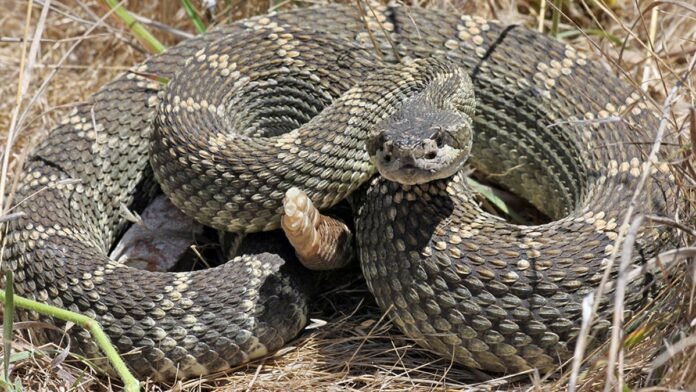Snake facts: 10 surprising, scary and very cool things to know
Why do snakes flick their tongues? Can snakes smell fear? This video reveals 10 amazing facts about rattlesnakes, flying snakes and other species.
The Republic
- Rattlesnakes are native to Shasta County and emerge in warm weather to bask in the sun.
- While venomous, rattlesnakes are shy and typically avoid humans and pets unless provoked.
- Residents can deter rattlesnakes by removing debris and rodent attractants from their property.
Hot weather is bringing out Shasta County’s shy sun-worshipping rattlesnakes, to the chagrin of humans who fear them.
Native to Shasta County, the Northern Pacific rattlesnake comes out from under rocks, logs and other hidden spots to bask in Redding’s heat. While they use their poisonous bite in self-defense, humans can usually avoid them. With careful human monitoring, so can their curious pets.
Rattlesnakes are part of urban wildlife like skunk, opossum and raccoon, said LeeAnne Smith of Redding, a 30-year veteran with Haven Humane Society and Animal Regulation. Once displaced by human development, they may still try to survive close to their territory.
At cooler times, people in the city and suburbs seldom see a rattlesnake unless they move objects in their yard or disturb one off-trail on a hike or bike.
They also live on rocky cliffs, like those along the Sacramento River. The cliffs along North Hilltop Drive in Redding are “rattlesnake heaven,” Smith said. There are plenty of rodents to eat and water sources are close.
But these shy snakes love hot sun, and will come out into the open almost anywhere to sunbathe in summer.
People can avoid these venomous snakes, help protect pets and make their property less inviting to them.
What to do if you see a rattlesnake
If you encounter a rattlesnake, stay calm and back away.
A misconception about rattlesnakes is they “go after” people, said Smith. The truth is they’re afraid of us.
Rattlesnakes are not generally aggressive toward people or pets unless provoked or threatened. They’ll usually retreat if given space, according to the California Department of Fish and Wildlife.
“Most of the time, the rattle of a rattlesnake is a defensive gesture,” said fish and wildlife spokesman Patrick Foy in Sacramento. “They don’t want to be stepped on. They want you to go away.”
But they don’t always rattle before they strike, Smith said. While they grow a rattle per year as they age, baby rattlesnakes are venomous as soon as they hatch. You may not get a warning sound.
For a list of things people can do to avoid rattlesnakes while they’re outdoors go to the California Poison Control System rattlesnake web page at calpoison.org/about-rattlesnakes.
Want to hear how a rattlesnake’s rattle sounds from the safety of your home? Go to britannica.com/video/rattle-rattlesnake
How to keep rattlesnakes away from your home
One way to avoid rattlesnakes is to make your property less attractive to them.
Smith suggests people inspect and clear debris from their property where they plan to turn over soil.
Remove anything that could attract the snakes’ prey — rats and other rodents — as well as the snakes. Feed pets indoors and move bird feeders away from the house.
For tips on making your home less inviting to rattlesnakes, the CDFW recommends people visit the California Herps rattlesnake information page at californiaherps.com/info/rattlesnakeinfo.
What to do if you get bitten by a rattlesnake
Rattlesnake bites are uncommon, according to California Poison Control‘s Assistant Medical Director Cyrus Rangan. Statewide, about 300 bites are reported to poison control annually.
If a rattlesnake does bite you, get immediate medical attention, according to poison control. Stay calm and keep the bite area elevated.
Don’t run. Don’t ice, cut into or constrict the bite area. Don’t try to suck out the venom.
Are you allowed to kill a rattlesnake in California?
While rattlesnakes are beneficial to the environment — eating mice and other rodents — if they settle under or next to your house they could bite curious children or pets.
According to the CDFW, it’s legal in most cases to kill most species of rattlesnakes in California, as long as it’s to protect life and property.
When killing them, remember they do feel pain. Kill then quickly for your own safety and to be as humane as possible, said Patrick Foy at the CDFW. Most people hit them very hard on the head with the back of a shovel.
Jessica Skropanic is a features reporter for the Record Searchlight/USA Today Network. She covers science, arts, social issues and news stories. Follow her on Twitter @RS_JSkropanic and on Facebook. Join Jessica on Record Searchlight Facebook groups Get Out! Nor Cal , Today in Shasta County and Shaping Redding’s Future. To support and sustain this work, please subscribe today. Thank you.
